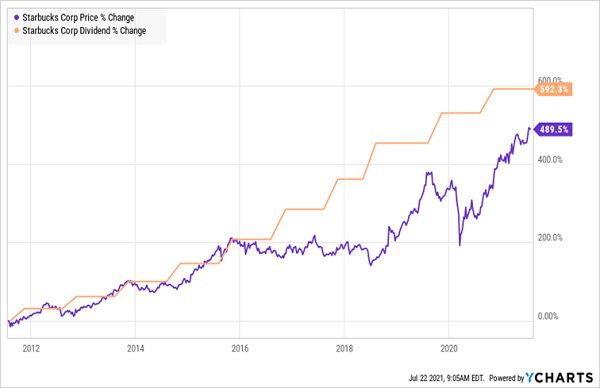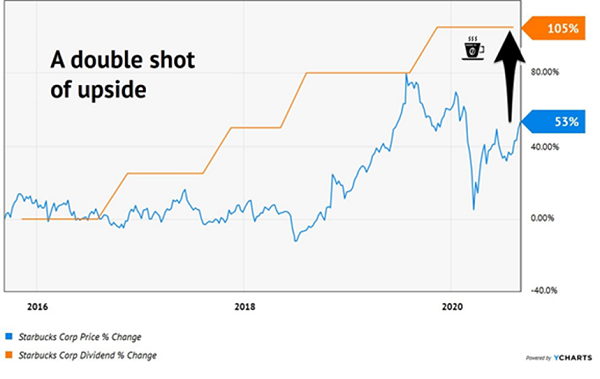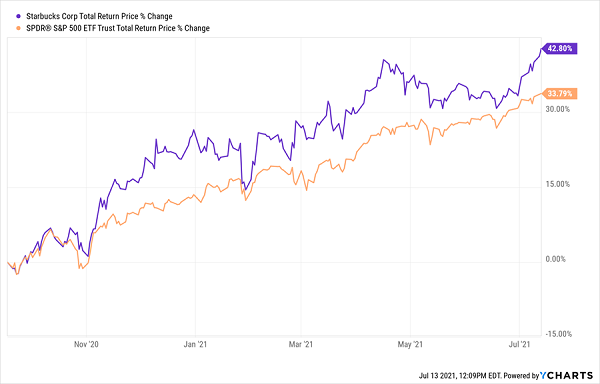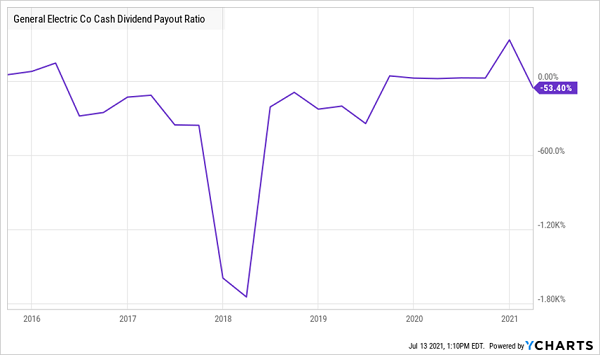Stocks are floating higher daily, and that’s prompted a lot of readers to ask me when they should sell a dividend stock and take profits—and when they should let it run.
You’re probably sitting on some nice capital gains these days, too, thanks to the COVID rebound rally, and have asked yourself the same question.
Today I’m going to give you three indicators I always use when making buy/sell decisions for my Hidden Yields dividend-growth advisory. It’s a simple setup that lets a too-often-ignored factor—dividend growth—dictate our next moves.
1. Buy (And Hang On!) When Dividends Outrun Share Prices
If you’re a regular reader of my column, what I’m about to say won’t surprise you: dividend growth is the No. 1 driver of share prices.
I’ve seen it time and time again. Just look at this chart of Starbucks (NASDAQ:SBUX), which has hiked its payout 592% in the last decade. It’s hard to argue that the company’s explosive payout growth hasn’t affected its share price—the stock is up almost the same amount—and the dividend-up, share-price-up pattern is clear.
Starbucks’ Dividend Jolts Its Stock
We can work this pattern for quick gains by buying when the share price breaks south of the dividend and then holding on as it catches up. This is the dynamic I saw setting up with Starbucks in September 2020.
Starbucks’ Shares Lag Its Dividend …
This, in turn, prompted me to issue a buy call on the stock in the September 2020 issue of Hidden Yields. Right on cue, SBUX began to close its “dividend gap,” delivering us a market-crushing 43% total return in just 10 months.
… And Then Bounce Back
Now that we’ve covered our dividend-driven buy indicator, let’s turn this strategy on its head and use it to tell us when it’s time to sell and take profits.
2. Sell When Share Prices Outrun Payout Growth
For this step, let’s look at insurer Assurant (NYSE:AIZ), which we sold in Hidden Yields in December 2019 for a 92% total return (including dividends) in just over four years.
During our holding period, Assurant shares continued to mostly track the company’s dividend, while jumping ahead from time to time. We were happy with this trajectory—though I did keep a close eye on it—so we let the stock run.
But the shares really took off in the last six months of 2019, as you can see below—and it quickly became clear that Assurant didn’t have the payout growth to support that leap:
AIZ’s Price Gain Buries Its Dividend … and We Check Out 
That huge gulf was a clear sell signal, so we took our 92% total return, dividends included, off the table. And as expected, Assurant has been thoroughly bested by the market since then:
Our “Dividend Indicator” Proves Its Value
Which brings us to the third factor we need to keep in mind at all times when buying (and especially selling) dividend growers.
3. Always Watch Payout Ratios Closely
A company’s payout ratio is the best indicator of whether its dividend can keep growing, and pulling the stock up, or if it’s headed for a cut, which will make our “dividend magnet” work in reverse—something we want to avoid at all costs.
The funny thing about the payout ratio is that most people use it the wrong way, looking at dividends paid as a percentage of the last 12 months of net income. But we want to use free cash flow (FCF) instead.
That’s because net income is an accounting figure that can be manipulated, while FCF is the amount of operating cash flow left after capital expenses—a simple number that can’t be fudged. Think of it as a snapshot of how much money a company has to repay debt, buy back shares or pay dividends at a given time.
I demand a ratio of 50% or less for stocks I recommend in Hidden Yields (though real estate investment trusts can have higher ratios, as these companies pull in predictable rents from tenants). If you own a “regular” stock whose payout ratio spikes above that line, especially well above, it’s time to sell. And you need to sell yesterday if your FCF payout ratio goes negative (meaning the company is paying dividends while generating negative cash flow).
The classic example is General Electric (NYSE:GE), a dividend go-to that saw its payout ratio go negative with the June 2016 payout.
That was the first sign a payout cut was in the cards, but it was largely ignored—until management slashed the dividend in half more than a year later, in December 2017. The move triggered a massive share-price drop from which the stock has yet to recover. (The payout has since been sliced twice more and now stands at just a penny a share.)
GE’s “Dividend Red Alert” Goes Unheeded
You’ll note that GE’s FCF payout ratio is still negative today, making it a blue-chip name you still need to keep clear of.
Disclosure: Brett Owens and Michael Foster are contrarian income investors who look for undervalued stocks/funds across the U.S. markets. Click here to learn how to profit from their strategies in the latest report, "7 Great Dividend Growth Stocks for a Secure Retirement."
